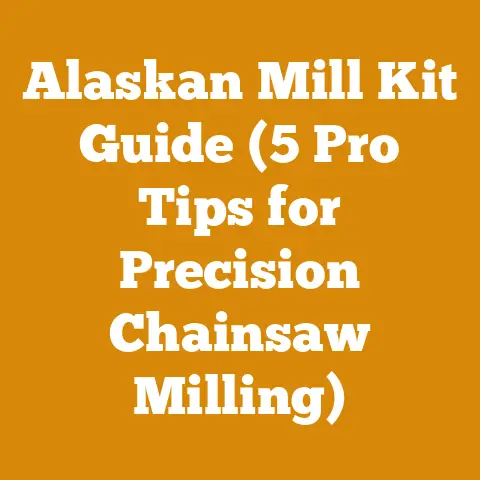Pitch Chainsaw Guide (5 Key Tips Every Woodworker Must Know)
Understanding Chainsaw Pitch: 5 Key Tips Every Woodworker Must Know
Chainsaw pitch, or kickback, is a sudden and forceful upward or backward movement of the chainsaw when the tip of the guide bar encounters an object or gets pinched. This can be incredibly dangerous, leading to serious injury. The five key tips I’ll cover will arm you with the knowledge and techniques to mitigate this risk.
1. Knowing Your Chainsaw and Its Components
Before you even think about cutting wood, you need to become intimately familiar with your chainsaw. This isn’t just about knowing where the on/off switch is; it’s about understanding how each component functions and how they contribute to the overall operation and safety.
-
Chainsaw Types: There are different types of chainsaws, each suited for specific tasks.
- Gas-powered chainsaws are generally more powerful and portable, ideal for felling trees and heavy-duty tasks. I typically use a Stihl MS 462 for felling larger trees because of its power-to-weight ratio.
- Electric chainsaws (corded and cordless) are quieter, lighter, and require less maintenance, making them suitable for smaller jobs like pruning and cutting firewood. My Ryobi 40V cordless chainsaw is my go-to for quick firewood prep.
- Pole saws are designed for trimming branches overhead.
-
Guide Bar: The guide bar supports the chain and directs its path. Different lengths are available, and the appropriate length depends on the size of the wood you’re cutting. Using a bar that’s too long for the chainsaw’s engine can lead to decreased performance and increased risk of kickback.
-
Chain: The chain is the cutting element of the chainsaw. Different types of chains are designed for different purposes.
- Full chisel chains are aggressive and cut quickly, but they’re also more prone to kickback.
- Semi-chisel chains are more forgiving and offer a good balance of cutting speed and safety.
- Low-kickback chains have guard links that reduce the risk of kickback. I always recommend these, especially for beginners.
-
Chain Brake: The chain brake is a crucial safety feature that stops the chain almost instantly in the event of kickback. Make sure you know how to activate the chain brake and that it’s functioning properly. Test it before each use.
-
Throttle Lock: This prevents accidental throttle engagement.
-
Anti-Vibration System: Reduces fatigue and improves control.
-
Bumper Spikes (Dogs): These metal teeth help you grip the wood and maintain control.
-
Understanding Terminology:
- Kickback Zone: The upper quadrant of the bar tip. Avoid contact with this area.
- Raker (Depth Gauge): Controls the depth of cut. Adjusting the rakers is crucial for optimal performance.
- Drive Links: The part of the chain that fits into the groove of the guide bar.
-
Maintenance: Regular maintenance is crucial for safety and performance. This includes:
- Sharpening the chain: A dull chain requires more force and increases the risk of kickback. I use a chainsaw file and guide to sharpen my chains regularly.
- Checking chain tension: A loose chain can derail and cause injury.
- Lubricating the chain: Proper lubrication reduces friction and extends the life of the chain and bar. I use a high-quality bar and chain oil.
- Cleaning the air filter: A dirty air filter reduces engine performance.
- Checking the spark plug: A faulty spark plug can cause starting problems.
Personal Experience: I remember one time when I was starting out, I ignored the chain tension and kept cutting until the chain derailed mid-cut. Luckily, I was wearing proper safety gear, but it was a close call. That taught me the importance of meticulous maintenance.
2. Proper Stance and Grip: Maintaining Control
Your stance and grip are fundamental to controlling the chainsaw and minimizing the risk of kickback. A solid, balanced stance allows you to react quickly and maintain control if kickback occurs.
-
Stance:
- Feet: Position your feet shoulder-width apart, with one foot slightly ahead of the other. This provides a stable base.
- Knees: Bend your knees slightly. This lowers your center of gravity and improves balance.
- Weight: Distribute your weight evenly between your feet.
- Avoid Overreaching: Never reach too far with the chainsaw. Move your feet to maintain a comfortable and balanced position.
-
Grip:
- Firm Grip: Hold the chainsaw firmly with both hands.
- Left Hand: Grip the front handle securely.
- Right Hand: Grip the rear handle and squeeze the throttle.
- Thumbs: Wrap your thumbs around the handles. This provides a secure grip and helps prevent the chainsaw from being pulled out of your hands.
- Avoid “White Knuckle” Grip: While a firm grip is essential, avoid gripping the handles so tightly that your hands become fatigued.
-
Body Positioning:
- Keep the Chainsaw Close to Your Body: This provides better control and reduces fatigue.
- Avoid Cutting Above Shoulder Height: This increases the risk of losing control.
- Maintain a Clear Line of Sight: Always keep your eyes on the cutting area.
- Position Yourself to the Side of the Cut: This reduces the risk of being struck by the chainsaw if kickback occurs.
-
Cutting Techniques:
- Use the Lower Portion of the Bar: This minimizes the risk of kickback.
- Avoid Plunge Cutting: Plunge cutting (inserting the tip of the bar directly into the wood) is a high-risk technique that should only be performed by experienced users.
- Be Aware of Pinch Points: Avoid situations where the bar can become pinched in the cut. Use wedges to keep the cut open.
Case Study: I was once working with a less experienced friend who was trying to fell a small tree. He was overreaching, his stance was unsteady, and he was cutting above shoulder height. I immediately stopped him and explained the importance of proper stance and grip. By correcting his technique, we were able to fell the tree safely and efficiently.
3. Recognizing and Avoiding Kickback Situations
Understanding the common situations that lead to kickback is crucial for prevention. Being aware of these scenarios allows you to anticipate and avoid them.
-
The Kickback Zone: As mentioned earlier, the upper quadrant of the bar tip is the most dangerous area. Avoid contact with this area at all costs.
-
Pinching: When the bar becomes pinched in the cut, the chain can suddenly stop, causing kickback. This is especially common when cutting trees that are under tension.
- Prevention: Use wedges to keep the cut open and prevent pinching.
- Technique: When felling trees, use the bore cut technique to relieve tension before making the final cut.
-
Hidden Obstacles: Nails, rocks, and other debris in the wood can cause the chain to snag and kickback.
- Prevention: Carefully inspect the wood before cutting.
- Technique: Use a metal detector to locate hidden metal objects.
-
Limbing: Limbing (removing branches from a felled tree) can be particularly dangerous because the branches can spring back and pinch the bar.
- Prevention: Work from the base of the tree towards the top.
- Technique: Cut branches from the underside first to relieve tension.
-
Cutting Small or Unstable Objects: Cutting small or unstable objects can cause them to move unexpectedly, leading to kickback.
- Prevention: Secure the object before cutting.
- Technique: Use a sawhorse or other support to stabilize the object.
-
Boring (Plunge Cutting): Avoid boring whenever possible.
- Technique: If boring is necessary, use a slow, controlled approach and be prepared for kickback.
Original Insight: I’ve found that visualizing the potential kickback path before each cut helps me anticipate and avoid dangerous situations. It’s like running a mental simulation to identify potential hazards.
4. Using Correct Cutting Techniques
Employing the right cutting techniques not only improves efficiency but also significantly reduces the risk of kickback.
-
Felling Techniques:
- The Notch Cut: The notch cut is a wedge-shaped cut that determines the direction of the fall.
- Angle: The notch should be cut at a 45-degree angle.
- Depth: The notch should be about one-third of the diameter of the tree.
- The Back Cut: The back cut is made on the opposite side of the tree from the notch cut.
- Height: The back cut should be slightly higher than the bottom of the notch cut.
- Leave a Hinge: Leave a hinge of uncut wood to control the direction of the fall.
- Bore Cut: Relieves tension and is used to control the direction of fall.
- Pushing: Use a pushing pole to guide the tree’s fall.
- Communication: Yelling “Timber!” before the tree falls is a standard safety practice.
- The Notch Cut: The notch cut is a wedge-shaped cut that determines the direction of the fall.
-
Limbing Techniques:
- Cut from the Underside First: This relieves tension and prevents the branch from pinching the bar.
- Use a Sawhorse: Support the branch to prevent it from moving unexpectedly.
- Avoid Cutting Above Shoulder Height: This increases the risk of losing control.
-
Bucking Techniques:
- Support the Log: Use supports to prevent the log from rolling or pinching the bar.
- Cut from the Top Down: When cutting a log that is supported at both ends, cut from the top down to prevent pinching.
- Cut from the Bottom Up: When cutting a log that is supported in the middle, cut from the bottom up to prevent pinching.
-
Boring (Plunge Cutting) Techniques (If Necessary):
- Use a Slow, Controlled Approach: Insert the tip of the bar slowly and carefully.
- Be Prepared for Kickback: Maintain a firm grip and be ready to react.
- Avoid Contact with the Kickback Zone: Keep the tip of the bar away from the sides of the cut.
Tool Specifications: For felling trees, I recommend a chainsaw with a bar length that is slightly shorter than the diameter of the tree. For limbing, a shorter bar is easier to maneuver.
Personal Story: I once witnessed a near-miss when a tree fell unexpectedly because the logger had not properly planned the felling cut. The tree landed just a few feet from where I was standing. That experience reinforced the importance of meticulous planning and execution.
5. Wearing Proper Personal Protective Equipment (PPE)
Even with the best techniques, accidents can still happen. Proper PPE is your last line of defense against injury.
-
Chainsaw Chaps: These are essential for protecting your legs from chainsaw cuts. I recommend chaps that cover the entire leg, from the groin to the ankle.
-
Eye Protection: Safety glasses or a face shield are crucial for protecting your eyes from flying debris.
-
Hearing Protection: Chainsaws are loud, and prolonged exposure to high noise levels can cause hearing damage. Use earplugs or earmuffs to protect your hearing.
-
Gloves: Gloves provide a better grip and protect your hands from cuts and abrasions.
-
Steel-Toed Boots: Steel-toed boots protect your feet from falling objects and chainsaw cuts.
-
Hard Hat: A hard hat protects your head from falling branches and other debris.
-
First-Aid Kit: Keep a well-stocked first-aid kit on hand for treating minor injuries.
-
Whistle: In case of an emergency, a whistle can be used to signal for help.
Data: Studies have shown that wearing proper PPE can significantly reduce the risk of chainsaw injuries. For example, chainsaw chaps have been shown to prevent or reduce the severity of leg injuries in a large percentage of chainsaw accidents.
Cost: The cost of PPE is a small price to pay for safety. A good pair of chainsaw chaps can cost around \$100, while a hard hat and safety glasses can be purchased for under \$50.
Strategic Advantage: Investing in high-quality PPE is a strategic advantage because it reduces the risk of injury, which can lead to lost work time and medical expenses.
Additional Safety Considerations:
- Never Work Alone: Always work with a partner in case of an emergency.
- Stay Hydrated: Drink plenty of water to prevent fatigue.
- Take Breaks: Take frequent breaks to avoid fatigue.
- Avoid Alcohol and Drugs: Never operate a chainsaw under the influence of alcohol or drugs.
- Be Aware of Your Surroundings: Watch out for hazards such as power lines, fences, and other obstacles.
- Plan Your Escape Route: Before you start cutting, plan an escape route in case the tree falls in an unexpected direction.
Green Wood vs. Seasoned Wood:
- Green Wood: Wood that has been freshly cut and contains a high moisture content. Green wood is heavier, harder to cut, and more prone to warping and cracking as it dries.
- Seasoned Wood: Wood that has been dried to a lower moisture content. Seasoned wood is lighter, easier to cut, and more stable than green wood.
Drying Methods:
- Air Drying: Air drying is the most common method of drying wood. The wood is stacked in a well-ventilated area and allowed to dry naturally.
- Stacking: Stack the wood with stickers (thin strips of wood) between the layers to allow for air circulation.
- Timing: Air drying can take several months to several years, depending on the species of wood and the climate.
- Kiln Drying: Kiln drying is a faster and more controlled method of drying wood. The wood is placed in a kiln and heated to a specific temperature.
- Timing: Kiln drying can take several days to several weeks.
- Dehumidification Drying: Dehumidification drying is a relatively new method of drying wood. The wood is placed in a chamber and the humidity is reduced.
- Timing: Dehumidification drying can take several weeks to several months.
Moisture Content Targets:
- Furniture: 6-8%
- Construction: 12-15%
- Firewood: 20% or less
Case Study: Firewood Stacking
I have experimented with different firewood stacking methods over the years. I found that the “Holz Hausen” (wood house) method, a circular stack, allows for excellent air circulation and efficient drying. I typically build my Holz Hausen about 6 feet in diameter and 6 feet high. I use a combination of hardwood (oak, maple) and softwood (pine, fir) for my firewood. The hardwood provides long-lasting heat, while the softwood ignites easily.
Hydraulic Splitter Efficiency:
Using a hydraulic log splitter has dramatically increased my efficiency in preparing firewood. A manual splitter can be tiring and time-consuming, especially when dealing with large or knotty logs. A hydraulic splitter can split logs much faster and with less effort. I use a 25-ton hydraulic splitter, which can handle logs up to 24 inches in diameter and 25 inches long.
Original Insights:
- Listen to Your Chainsaw: A chainsaw that is running smoothly will sound different from one that is struggling. Pay attention to the sound of your chainsaw and learn to recognize when it is not operating properly.
- Respect the Power: A chainsaw is a powerful tool that should be treated with respect. Never become complacent or take shortcuts.
- Continuous Learning: There is always more to learn about chainsaw safety and techniques. Continue to educate yourself and seek out opportunities to improve your skills.
Next Steps:
- Review your chainsaw’s owner’s manual: Familiarize yourself with the specific features and safety recommendations for your chainsaw model.
- Practice proper stance and grip: Spend time practicing your stance and grip until they become second nature.
- Identify potential kickback situations: Before each cut, take a moment to assess the situation and identify potential hazards.
- Wear proper PPE: Always wear proper PPE when operating a chainsaw.
- Take a chainsaw safety course: Consider taking a chainsaw safety course to learn from experienced professionals.
By following these five key tips and staying vigilant, you can significantly reduce the risk of chainsaw pitch and enjoy safer, more productive woodworking. Remember, safety is always the top priority.






